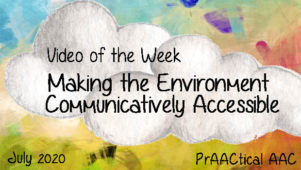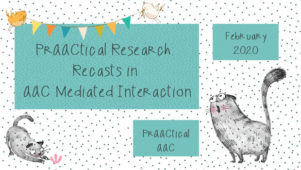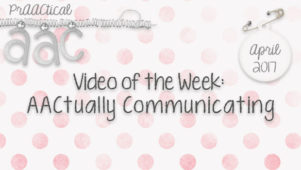RECASTING: A LANGUAGE FACILITATION STRATEGY

“Strategies Are The Secret To Learning”
There are many ways to teach speech and language but we think it is important to remember that the goal should be to teach spontaneous language. So all the strategies we discuss will be part of a responsive conversational style and be real or authentic to conversation. They will be for the facilitator (most often the adult) to use. There should be a purpose or strategy applied to each and every thing we communicate or ‘say’ when teaching language. This extra ‘dose’ of language facilitation is what transitions ordinary talking or language stimulation to specific language teaching/ or speech-language intervention.
At the beginning of the month, we introduced language facilitation strategies by talking about aided language input, which is an authentic way of adding visual language and AAC modeling to the conversation. This week we are talking about RECASTS.
Recasts serve to add or correct information without obstructing the natural flow of communication. Recasting is another form of modelling. The recast occurs when the facilitator modifies a learners utterance by adding new or different grammar (syntactic) or word meaning information (semantic) information. Think of it as the facilitator repeating the ‘Right Thing’ or a ‘New Thing’.
How to use Recasts
Use them Frequently
Emphasize with loudness and pause time the corrected or new information
Do Not Make the learner repeat (repetition may happen naturally but repetition is not a
requirement of this strategy and should not be expected)
Use them Frequently
Emphasize with loudness and pause time the corrected or new information
Do Not Make the learner repeat (repetition may happen naturally but repetition is not a
requirement of this strategy and should not be expected)
Sample Recasts:
| Learner | Facilitator |
| “want cookie” | “I love cookies, my favorite are chocolate chips” OR“I want the cookie please” |
| “he walket in” | “yes,he WALKED in” |
| “boy are playing” | “wow, the boy is playing ball” |
| I want read. | “oh you want TO read.” ORWhat do you want to read?” |
| *If you want practice, think of your own examples. The more we think and plan our language facilitation strategies, the easier they are to use. | |
| **Keep in mind it does not matter HOW a learner says the message- The message can be through spoken speech, No Tech Symbols, AAC devices/apps |
The Sum of Language facilitation Strategies Works Best and We Can Keep Adding More:
Resources to Learn More About Language Facilitation Strategies
- AAC Language Lab
- Hanen Centre
- Live Speak Love- Top 5 Ways to Encourage Spontaneous Language
- Washington Learning Systems
- Speech-Language-Therapy dot com- Delivering feedback Modeling and Recasting
- The Useful Box Blog- Recasting: A simple strategy for improving your child’s speech
- Our List of Language Facilitation Strategies
Filed under: Strategy of the Month
Tagged With: communication, language, language facilitation strategy, recasts
This post was written by Robin Parker






5 Comments
what is the difference between expansion and recasting ?
Yvonne, thanks for your question. The primary difference relates to the function of each one. The function of recasts is to provide a correct model of a sentence that has an error in it so that the child can learn from that. So if a child said ‘Mama home go,’ I might recast that as “Mama went home.” Recasts are used when there is something wrong in the sentence and you want to give a correct model without being intrusive. Expansions serve a different function: to model longer sentences. So if a child said ‘that loud’ I might expand that to “That truck was loud.” Hope that helps.
I use recasting all the time. I was wondering if you might have a good measureble goal that goes along with the strategy of recasting?
Tammy, I think any well-written language goal would work but here’s one example “Given focused language stimulation, Student will use the conjunctions but, because, and although correctly in 6/10 opportunities during structured activities.”
Hello.
I really like the explanations.
I was wondering if you have any intersting articles related to this tecniques, such as recasting, modelling, scaffolding, prolonged and slow speech and imitation.
Thank you so much in advanced.